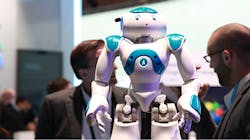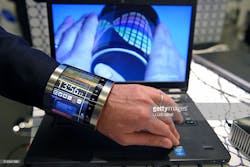Mobile World Congress: A New Case for Smart Manufacturing
At the periphery of the Mobile World Congress in Barcelona last month—just whispers at the fringes of the 110,000-square-meter tech extravaganza—interest finally started to grow beyond the usual consumer products innovations.
Sure, all 101,000 attendees of this record crowd are heading home across the world with their minds typically agog with all of the latest sci-fi gadgetry, filled with the promises of home robots, virtual and augmented realities, new phones, new gadgets, IoT, and all the tech they could possibly wear.
A flexible screen that fits the wrist by Flexenable is presebted on the last day of the Mobile World Congress in Barcelona on February 23, 2016. The world's biggest mobile fair, held from February 22 to February 25. / AFP / LLUIS GENE (Photo credit should read LLUIS GENE/AFP/Getty Images)
But some are also going home with a new vision: Smart manufacturing, smart factories, Industrial Internet, Industrial IoT.
After nearly a decade of quiet growth, these industrial trends are finally coming out from behind the flash of the consumer electronics world, and are showing signs of growth that could be much more explosive than anything we’ve seen before.
In his keynote at the Congress, William Ruh, CEO of GE Digital, laid the groundwork for this discussion. While the last decade was dedicated to developments in the consumer and enterprise world, he told the crowd, “The next decade is the Industrial Internet.” For that market, he added, “this is probably the biggest opportunity we have seen in two to three decades.”
And that is by no means hyperbole.
William 'Bill' Ruh, chief digital officer of General Electric Co., gestures as he speaks during a keynote sessionat the Mobile World Congress in Barcelona, Spain, on Wednesday, Feb. 24, 2016. Mobile World Congress, an annual phone-industry event organized by GSMA Ltd., runs from Feb. 22 to Feb. 25. Photographer: Chris Ratcliffe/Bloomberg via Getty Images
For all of our talk about the Internet of Things and all of the brilliant stuff it will allow us to do with our lives, private applications for the technology are just a drop in the ocean of industrial potential.
This movement in the technology makes sense. It makes a lot more sense than the consumer electronics explosion.
Big data was born from the manufacturing field. Robotics was born there. As were mobile communications, networking, sensors, and controls.
All of these devices and technologies are industrial tools lent to the consumer world to commoditize, improve, and scale up. The growth in the consumer market all began on a plant floor.
But now we are at a second inflection point.
Now, with ubiquity of consumer electronics and all these sensors and VR equipment, these cheap, cheap devices doing amazing, amazing things, it’s manufacturing’s turn to take it back and see what they can do.
The timing for this couldn’t be better.
The technologies are there for this. The infrastructure is there. The money is there. The cybersecurity is… well, almost there. The timing is right for a full scale revolution. Someone just has to pull the trigger.
BARCELONA, SPAIN - FEBRUARY 24: Visitors attend a demonstration of a robot named 'Watson' at the IBM stand on day 3 of the Mobile World Congress 2016 on February 24, 2016 in Barcelona, Spain.The annual Mobile World Congress hosts some of the world's largest communications companies, with many unveiling their latest phones and wearables gadgets. (Photo by David Ramos/Getty Images)
This is why it seems so significant to have this enter the conversation at Mobile World Congress.
The consumer industry is driven by desire. The personal greed for the latest and greatest, the most connected and fast gadgets out there. The industrial world, however, has a legitimate need for these things.
To survive in this century and this new market, manufacturers need all of these tools and assets to work for them, to wring the most productivity out of every worker and every machine, to build the best parts and the best stuff in the cheapest, most efficient, highest quality manner possible.
They can’t do that in the old-school manufacturing methods. These technologies are critical for the next wave of growth.
And once it all comes together, once manufacturing’s rise comes from the whispers of the edges shows like this, that growth is going to be blinding.
Travis Hessman
Editor-in-Chief
New Equipment Digest
About the Author
Travis Hessman
VP of Content, Endeavor Business Media
Travis Hessman is the VP of Content for Endeavor Business Media. Previously, Travis was the Editor-in-Chief for Industry Week and New Equipment Digest as well as the Group Editorial Director for Endeavor's Manufacturing Group.
He began his career as an intern at IndustryWeek in 2001 and later served as IW's technology and innovation editor. Today, he combines his experience as an educator, a writer, and a journalist to help address some of the most significant challenges in the manufacturing industry, with a particular focus on leadership, training, and the technologies of smart manufacturing.





